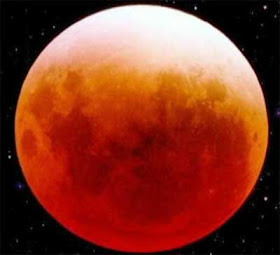The concept of eclipse is today explained scientifically and is not a matter of mystery anymore. There were times when it was mysterious as well as scary. Specially the solar ones. One should be a bit cautious of the solar ones even today, for looking directly in the sun can damage the eyes.
Nothing like that for the lunar eclipse though. See as much as you want. Though I could not take any pictures on my own due to clouds in Bangalore, some early photos can be seen here.
It is interesting to note that India had taken some great astronomical leaps long, long ago! I am not talking about identifying the pole star and Ursa Major etc. Even more specific.
Aryabhata आर्यभट/ आर्यभट्ट (476–550 CE) mentions the reasons for eclipse in no unclear terms.
चन्द्रो जलमर्कोऽग्निर्मृद्भूश्छायापि या तमस्तद्धि |
छादयति शशी सूर्यं शशिनं महती च भूच्छाया ||
[आर्यभाटीय, गोलपादः 37]
chandro jalam_arko'gnir_mRid_bhUsh_chhAyApi yA tamas_taddhi |
chhAdayati shashI sUryam shashinam mahatI cha bhUch_chAyA ||
[i.e. chandraH jalam, arkaH agni, mRit bhUH, chAyA api yA tamaH tat hi
chAdayati shahI suryam, shashinam mahatI cha, bhUH chAyA ]
[i.e. chandraH jalam, arkaH agni, mRit bhUH, chAyA api yA tamaH tat hi
chAdayati shahI suryam, shashinam mahatI cha, bhUH chAyA ]
[AryabhAtIya, Gola-pAdaH 37]
"moon is of water, sun is of fire, earth is of soil, and its shadow is of darkness.
the moon covers the sun, and the great shadow of the earth covers the moon."
[The book of Aryabhata, Sphere section, #37]
He then discusses in detail, how to calculate the size of Earth's shadow and the size of the eclipsed part. These computations were improved by later astronomers a bit. His calculations were so accurate that 18th century scientist Guillaume Le Gentil, during a visit to Pondicherry, India, found the Indian computations of the duration of the lunar eclipse of 30 August 1765 to be short by 41 seconds, whereas his charts were long by 68 seconds. (Wikipedia)
Considered in modern English units of time, Aryabhata calculated the sidereal rotation (the rotation of the earth referencing the fixed stars) as 23 hours, 56 minutes, and 4.1 seconds; the modern value is 23:56:4.091. Similarly, his value for the length of the sidereal year at 365 days, 6 hours, 12 minutes, and 30 seconds (365.25858 days) is an error of 3 minutes and 20 seconds over the length of a year (365.25636 days).
He even gave the times for Jupiter's revolution, distance of Sun and earth, earth circumference. He also pioneered in trigonometry and trigonometric calculations. Tables of sine and cosine of angles were calculated that are even today precise to 3-4 places of decimal point.
Some of his statements on astronomy, in AryabhAtIya golapAda chapter, worth noting are:
1. Sun illuminates half of the earth, moon and planets, the other half remains dark. [5]
2. Heavenly bodies seem to move westward at equator, similar to parallax by which the forest seems to move from a moving boat. [9]
3. Sri Lanka 90 degrees from pole, Ujjain 22.5 degree north of Lanka. [14]
4. Cause of eclipses due to shadow of moon and earth and many calculations around it. [37]
5. Color of moon at different parts of total eclipse! [46]
6. At poles, Sun visible for 6 months, on moon, sun visible for half a lunar month! [17]
He did a lot more in mathematics including calculating the value of Pi correct up to 4 decimal places and knowing that it was indeterminate. Adding sequence of squares and cubes, and finding solutions to what is now called as Diophantine equations (Ax + By = C, A, B, C are integer, find integer solutions for x and y)
His work was translated early on in Arab and led to the advance of astronomy in Arab and Europe. More details, click here.
(c) Shashikant Joshi । शशिकांत जोशी । ॐ सर्वे भवन्तु सुखिनः ।


No comments:
Post a Comment
Please do add your name and place, after the comment.